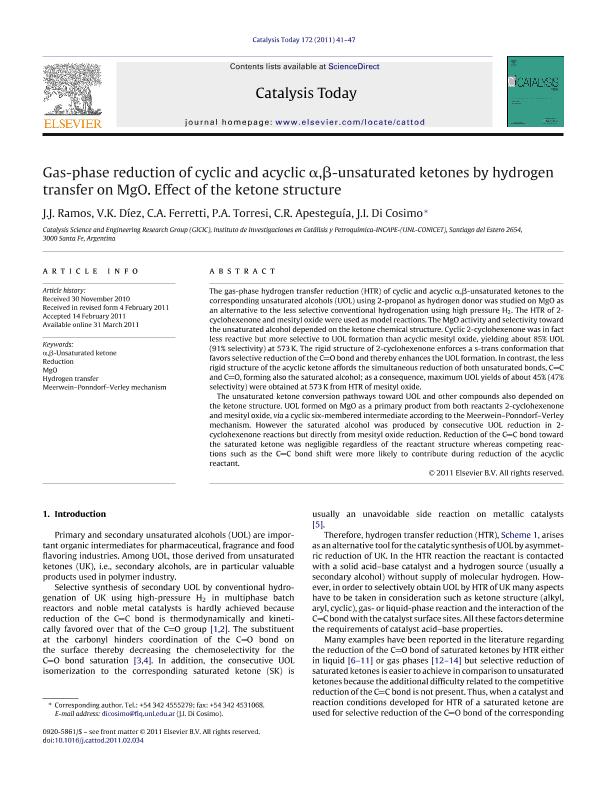Mostrar el registro sencillo del ítem
dc.contributor.author
Ramos, J. J.
dc.contributor.author
Diez, Veronica Karina

dc.contributor.author
Ferretti, Cristián Alejandro

dc.contributor.author
Torresi, Pablo Antonio

dc.contributor.author
Apesteguia, Carlos Rodolfo

dc.contributor.author
Di Cosimo, Juana Isabel

dc.date.available
2023-09-19T14:30:38Z
dc.date.issued
2011-08
dc.identifier.citation
Ramos, J. J.; Diez, Veronica Karina; Ferretti, Cristián Alejandro; Torresi, Pablo Antonio; Apesteguia, Carlos Rodolfo; et al.; Gas-phase reduction of cyclic and acyclic α,β-unsaturated ketones by hydrogen transfer on MgO. Effect of the ketone structure; Elsevier Science; Catalysis Today; 172; 1; 8-2011; 41-47
dc.identifier.issn
0920-5861
dc.identifier.uri
http://hdl.handle.net/11336/212057
dc.description.abstract
The gas-phase hydrogen transfer reduction (HTR) of cyclic and acyclic α,β-unsaturated ketones to the corresponding unsaturated alcohols (UOL) using 2-propanol as hydrogen donor was studied on MgO as an alternative to the less selective conventional hydrogenation using high pressure H 2. The HTR of 2-cyclohexenone and mesityl oxide were used as model reactions. The MgO activity and selectivity toward the unsaturated alcohol depended on the ketone chemical structure. Cyclic 2-cyclohexenone was in fact less reactive but more selective to UOL formation than acyclic mesityl oxide, yielding about 85% UOL (91% selectivity) at 573 K. The rigid structure of 2-cyclohexenone enforces a s-trans conformation that favors selective reduction of the CO bond and thereby enhances the UOL formation. In contrast, the less rigid structure of the acyclic ketone affords the simultaneous reduction of both unsaturated bonds, CC and CO, forming also the saturated alcohol; as a consequence, maximum UOL yields of about 45% (47% selectivity) were obtained at 573 K from HTR of mesityl oxide. The unsaturated ketone conversion pathways toward UOL and other compounds also depended on the ketone structure. UOL formed on MgO as a primary product from both reactants 2-cyclohexenone and mesityl oxide, via a cyclic six-membered intermediate according to the Meerwein-Ponndorf-Verley mechanism. However the saturated alcohol was produced by consecutive UOL reduction in 2-cyclohexenone reactions but directly from mesityl oxide reduction. Reduction of the CC bond toward the saturated ketone was negligible regardless of the reactant structure whereas competing reactions such as the CC bond shift were more likely to contribute during reduction of the acyclic reactant.
dc.format
application/pdf
dc.language.iso
eng
dc.publisher
Elsevier Science

dc.rights
info:eu-repo/semantics/openAccess
dc.rights.uri
https://creativecommons.org/licenses/by-nc-sa/2.5/ar/
dc.subject
Α,Β-UNSATURATED KETONE
dc.subject
HYDROGEN TRANSFER
dc.subject
MEERWEIN-PONNDORF-VERLEY MECHANISM
dc.subject
MGO
dc.subject
REDUCTION
dc.subject.classification
Otras Ingeniería Química

dc.subject.classification
Ingeniería Química

dc.subject.classification
INGENIERÍAS Y TECNOLOGÍAS

dc.title
Gas-phase reduction of cyclic and acyclic α,β-unsaturated ketones by hydrogen transfer on MgO. Effect of the ketone structure
dc.type
info:eu-repo/semantics/article
dc.type
info:ar-repo/semantics/artículo
dc.type
info:eu-repo/semantics/publishedVersion
dc.date.updated
2023-07-07T21:03:34Z
dc.journal.volume
172
dc.journal.number
1
dc.journal.pagination
41-47
dc.journal.pais
Países Bajos

dc.journal.ciudad
Amsterdam
dc.description.fil
Fil: Ramos, J. J.. Consejo Nacional de Investigaciones Científicas y Técnicas. Centro Científico Tecnológico Conicet - Santa Fe. Instituto de Investigaciones en Catálisis y Petroquímica "Ing. José Miguel Parera". Universidad Nacional del Litoral. Instituto de Investigaciones en Catálisis y Petroquímica "Ing. José Miguel Parera"; Argentina
dc.description.fil
Fil: Diez, Veronica Karina. Consejo Nacional de Investigaciones Científicas y Técnicas. Centro Científico Tecnológico Conicet - Santa Fe. Instituto de Investigaciones en Catálisis y Petroquímica "Ing. José Miguel Parera". Universidad Nacional del Litoral. Instituto de Investigaciones en Catálisis y Petroquímica "Ing. José Miguel Parera"; Argentina
dc.description.fil
Fil: Ferretti, Cristián Alejandro. Consejo Nacional de Investigaciones Científicas y Técnicas. Centro Científico Tecnológico Conicet - Santa Fe. Instituto de Investigaciones en Catálisis y Petroquímica "Ing. José Miguel Parera". Universidad Nacional del Litoral. Instituto de Investigaciones en Catálisis y Petroquímica "Ing. José Miguel Parera"; Argentina
dc.description.fil
Fil: Torresi, Pablo Antonio. Consejo Nacional de Investigaciones Científicas y Técnicas. Centro Científico Tecnológico Conicet - Santa Fe. Instituto de Investigaciones en Catálisis y Petroquímica "Ing. José Miguel Parera". Universidad Nacional del Litoral. Instituto de Investigaciones en Catálisis y Petroquímica "Ing. José Miguel Parera"; Argentina
dc.description.fil
Fil: Apesteguia, Carlos Rodolfo. Consejo Nacional de Investigaciones Científicas y Técnicas. Centro Científico Tecnológico Conicet - Santa Fe. Instituto de Investigaciones en Catálisis y Petroquímica "Ing. José Miguel Parera". Universidad Nacional del Litoral. Instituto de Investigaciones en Catálisis y Petroquímica "Ing. José Miguel Parera"; Argentina
dc.description.fil
Fil: Di Cosimo, Juana Isabel. Consejo Nacional de Investigaciones Científicas y Técnicas. Centro Científico Tecnológico Conicet - Santa Fe. Instituto de Investigaciones en Catálisis y Petroquímica "Ing. José Miguel Parera". Universidad Nacional del Litoral. Instituto de Investigaciones en Catálisis y Petroquímica "Ing. José Miguel Parera"; Argentina
dc.journal.title
Catalysis Today

dc.relation.alternativeid
info:eu-repo/semantics/altIdentifier/url/https://www.sciencedirect.com/science/article/pii/S0920586111001507
dc.relation.alternativeid
info:eu-repo/semantics/altIdentifier/doi/https://doi.org/10.1016/j.cattod.2011.02.034
Archivos asociados
